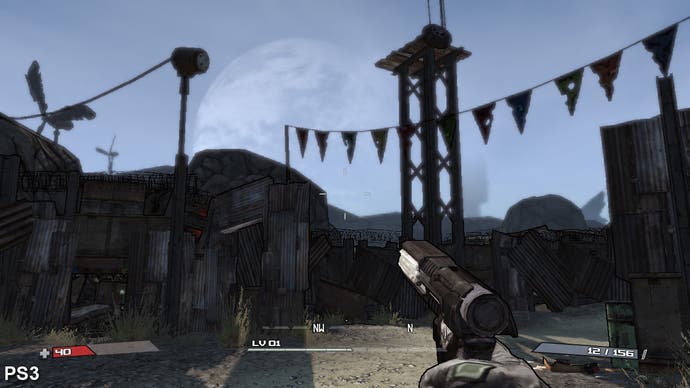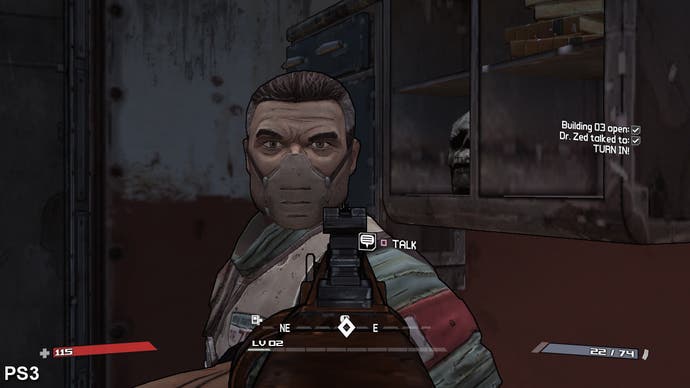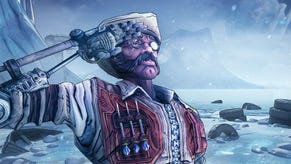Face-Off: Borderlands
Skag binge.
With its fine fusion of stylised visuals, accomplished shooting gameplay, superb co-op elements and MMO-style character building, Borderlands should deliver developer Gearbox plenty of success. Gifted with an impressive 8/10 review score on Eurogamer, it's clearly a highly desirable game, but out of the three SKUs available, which is the most worthy of your investment?
Back in days of yore, cross-platform projects from PC-centric developers like Gearbox would follow a predictable pattern: the computer version could be seen as the "master game", from which the console versions would be derived, with varying levels of compromise attached to each of the latter. However, there has been a fundamental shift in recent times to developers concentrating mostly on the console renditions, with only minor technical improvements made on the PC side of things. This is perhaps most noteworthy in terms of texture quality; art assets that target 720p look a little lacklustre at 1080p, as the additional texture definition required to really make an impression simply isn't there.
This new approach also "works" in that the baseline enthusiast PC is likely to contain more processing muscle and, crucially, memory than the Xbox 360 and PS3. The consoles have defined the baseline, and even a relatively modest entry-spec PC with an £80 graphics card can easily surpass that general performance level, hence we see fairly basic ports with frightening regularity.
Borderlands is an interesting combination of the two philosophies, and proof that perhaps Gearbox still has a lot of love left for the PC and is willing to put a bit of extra effort into the code. The fact that the game is based on Unreal Engine 3 helps matters too: while it targets the console baseline, out of the box it offers a toybox of effects and a different selected range of them can be deployed on either console.
So, which console gets which effects? Time to deploy the comparison video for starters, before we go in-depth.
To check out how all three versions stack up against one another, this video is also replicated with the PC build factor in, so check out the PC/PS3 companion vid, and the PC/Xbox 360 version too. For some detailed examination, there's also a 720p triple-format comparison gallery extracted from the obligatory 24-bit RGB lossless Digital Foundry captures.
As you can see, there's not much in it. Differences are subtle, none of them are game-breaking, and similar to Batman: Arkham Asylum (another recent Unreal-powered hit), Borderlands remains highly recommended regardless of the gaming platform.
However, the spectre of Unreal Engine also seems to dictate that it is the Xbox 360 version of the game that commands visual and performance advantages over its PS3 counterpart. Similar to Batman: Arkham Asylum, the 360 version employs the use of screen-space ambient occlusion (SSAO) to give objects in the gameworld a sense of depth and "belonging" that are not present at all in the PS3 build. This was barely perceptible in Rocksteady's Dark Knight game, owing to the muted colour scheme, but in the cel-shaded world of Borderlands, it's a subtle, but pleasing addition.
Additionally, an effect called "flare out" on the PC build appears to have been added to the Xbox 360 version, producing bloom-style effects that are only really noticeable when the sky occupies a lot of the screen - which isn't going to be particularly often. It looks pretty nice though, as you can see here:


It has been noted that the PS3 build of Borderlands enjoys advantages of its own though. In particular, comments have been made about the fact that the Xbox 360 game only occupies 3.3GB of hard drive space via NXE install and this has been correlated to the appearance of lower resolution textures in the game itself. Like these for example:


In these isolated cases, there's clear evidence that the PS3 is closer to the PC "master build" in that there's little doubt that the Xbox 360 version is running with lower-detail assets. Quite why is anyone's guess. PS3's 2.3GB mandatory install offers up plenty of extra bandwidth for smoother streaming, but it seems unlikely that these particular textures would cause the DVD drive issues.
It's equally important to point out that in producing these shots we had to go looking for them and their presence throughout the game is very rare. In the vast majority of cases, everything is like-for-like, and unless you spend your time bumping up close to every in-game object (or in the case of the doctor shot above, zooming in using ironsights), you won't be able to tell the difference. Indeed, it's obvious that each version has been given some minor cutbacks in this area. On the main view weapon, for example, you can clearly see dialled-back normal maps on the PS3 game, while the same effect is like-for-like between 360 and PC.
And in terms of that 3.3GB install? Well, the PC game may well be over the double the size when installed to hard disk (compression really isn't an issue on that platform!) but the PS3 game data is a mere 3.47GB. In an age where the storage capacity of the DVD is constantly being brought into question, a triple-A title like Borderlands would still give you change from a single-layer disc.







